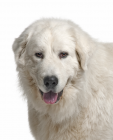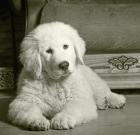Maremma Sheepdog
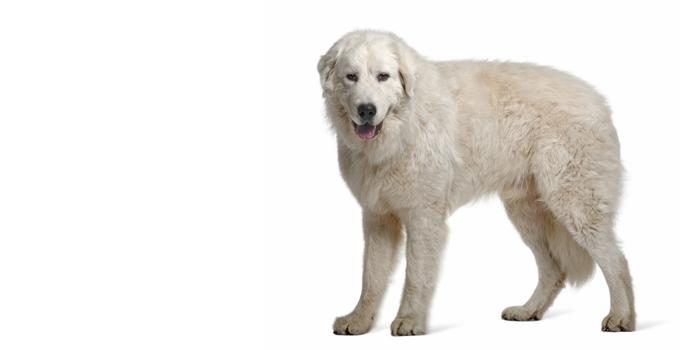
In my own words
I’m a pretty good guardian, even if I do say so myself. Want me to look after you sheep? Or I can look after the house? Even the children, I can look after anything because that’s my job! As long as I’ve got some work to do, I’m happy. It can a bit quiet and scary out in the countryside alone at night so don’t worry, I can keep an eye for you. My favourite place to be is the countryside, I can’t stand being cooped up! I don’t really like the city too much. It’s so busy, isn’t it? And there’s no grass to run in or sheep to look after. I’d really love to live on a farm and have my own flock of sheep to look after. That would be great, wouldn’t it?
Did you know, my kind originally come from Italy? That’s where we were bred to look after the sheep, isn’t that cool? Of course, I don’t always look after sheep but I definitely want to keep working. I like being busy! I have to keep active to stay in shape too...
My ideal owner(s)
Farmers and ranchers
Active singles
Families
Cold-climate dwellers
What they say about me
Gentle and nurturing
Protective
Dependable
Playful
Loyal
Please read on, to find out more about me, and whether I will be someone you can be happy with for the next 14 years, or even longer!
Is this Maremma for you?
Test your knowledge about the Maremma
Information essential about the Maremma Sheepdog
Kennel Club Group:
Pastoral
(Not AKC recognised)
Category:
Maremma Sheepdogs belong to the pastoral group and are used as guard dogs for herds, as companions and seen in the show-ring.
Size:
Giant: Weight Male 77 – 99 lb (35 – 45 kg) Female 66 – 88 lb (30 – 40 kg)
Height Male 25.5 – 28.5” (64.8 – 72.4 cm) Female 25 – 25” (63.5 – 68.6 cm)
Popularity:
Today the Maremma is still the most popular and common sheepdog in Italy.
Breed History:
The Maremma originated in (and was named after) a region of Tuscany where it has guarded sheep and livestock for centuries. Some documents tract the Maremma back to Ancient Rome. Ancient Italian writers have mentioned the dog and a 13th century picture in the church of Santa Maria in Florence depicts the Maremma. The original stock came from migrating Eastern shepherd dogs which developed into the individual breeds particular to a region, for example, the French Pyrennean Sheepdog and the Hungarian Kuvasz. In Italy, the shorter coated Maremmano and the longer backed Abruzzese merged into one breed sometime in the 1860s, due to seasonal movement of flocks.
It is said that the courageous Maremma can ward off wolves, bears and human predators and their solitary function (both past and present) is guarding flock and property. The Maremma was first brought to England in 1931 with the dog ‘Drago of Castlenuova’. A mate was then brought over and a breeding programme was set up by Helen Home-Robertson and Mrs J. M. Pryor. Maremma’s now have their own class at Crufts and are generally used in this country for estate guard dogs and pets. Still popular in its native country, the Maremma Sheepdog is a helpful worker and companion in the United States, Australia and elsewhere.
Character:
The Maremma is sturdy, dignified and carries itself with a majestic appearance. It is a large breed and is well-built with an aloof expression. This is a true working breed and is not intended to solely be a pet as they are very intelligent, independent and alert. The Maremma is extremely adept at guarding farm, flock and family and is extremely loyal, affectionate and dedicated to its family and work. They do well with other dogs, pets and are good with children. They are always on the look out and have a tendency to bark.
Temperament:
This breed is happiest when at working guarding its flocks as it has a very strong and well developed guarding instinct. They are loyal to their master, devoted to their flock but intolerant of intruders making this breed a good guard dog. The Maremma is intelligent but can be difficult to train due to its strong willed nature and needs to be socialised well at a young age or it might not be well behaved with children and other dogs. They are good with other animals if they have been brought up them and well socialised at a young age. They are reasonably tolerant of others unless they feel their charges are being threatened and although it is not aggressive, this dog is courageous when protecting its flock and home.
Conformation:
The Maremma has a large, sturdy frame and has a rough, thick and slightly wavy coat that is usually white and sometimes has patches of yellow and orange. It has a broad, triangular head with a slightly tapered muzzle and dark, almond shaped eyes. The ears are small and high set. The neck should show strength as it leads to long, sloping shoulders and straight, well-boned forelegs. The frame is heavy boned and muscular. The feet are oval and well arched. The back should be strong and straight with a low set tail, reaching past the hocks. Its hindquarters are broad and muscular with well let down hocks and moderately bent stifles. Coat:
The coarse outercoat is white, ivory or pale fawn while the undercoat is thick and dense. Together both coats should waterproof the dog. The puppy coat is soft and woolly, growing harsher between six and twelve months. Puppies are always white in colour.
Colour:
The coat is usually solid white, ivory or pale fawn in colour although orange or yellow tints can occur around the ears
Training:
This breed requires early socialisation and obedience training. Early socialisation and training will ensure this breed gets along well with smaller pets and children.The Maremma will regard its master as an equal and friend and do not respond well to harshness. Training must be done with respect and consistency. This breed is strong willed so can be difficult to train. It is loyal to one master but training may still take considerable effort.
Care:
The Maremma is prone to bloating so it is recommended to feed it several smaller meals in the day rather than one large meal. Rough coated Maremmas are not prone to matting and tangling like the fine-coated versions but both types shed during spring and autumn. Maremmas that live mostly inside will need more brushing and clipping than their working counterparts. Regular brushing and grooming will remove loose hair and more attention is needed during shedding periods. The ears and paw pads need to be checked often for debris. Due to their rarity and selective breeding, this breed is not well suited to warm climates. Whilst this is quite a large dog, on reaching maturity it is not a big eater and therefore can be kept on a low maintenance diet. It matures slowly, not reaching full maturity till two years so it is advised that it be fed a special diet for giant breed puppies. It is important not to overfeed the puppies but be aware that there are growth spurts. Poor nutrition in its youth will lead to skeletal problems in older dogs.
Health:
The lifespan of a healthy individual is up to 14 years. If you buy from a reputable, responsible breeder, health problems should not occur. The Maremma is a hardy breed but can be susceptible to some ailments common to large breeds. They can suffer from hip dyplasia, achondroplasia and slipped patellas. Veterinary surgeons must be careful when anaesthetising this breed as it is sensitive to anaesthetics.
Exercise:
This breed is not recommended for apartment or city living. The Maremma requires a rural setting an an excessive amount of physical exercise and mental stimulation everyday. They do best with room to roam and enjoy having a job to do. While this breed can take a huge amount of exercise, it is not a necessity. This breed is used for guarding a herd and has stamina to work all day as they are endurance dogs rather than high energy. Between 40 and 60 minutes exercise a day is sufficient for this breed.
You may also like:
If you like Maremma Sheepdogs, you may be interested in breeds of the same size »
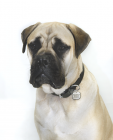

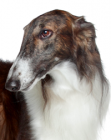
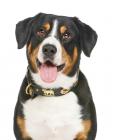
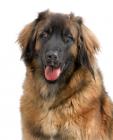
If you like Maremma Sheepdogs, you may like other breeds with similar characteristics »



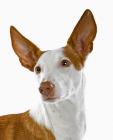

If you like Maremma Sheepdogs, you may be interested in these other pastoral dogs »

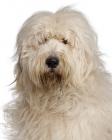
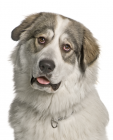


Advice on choosing your breed »
Find an animal shelter or rescue home where a Maremma Sheepdog is waiting for a new home »
The following grid gives a fast track review which covers all breeds. You can apply it to help you decide if a Maremma Sheepdog is suitable for you, the environment where you live, your personality and your lifestyle. On the grid, 1= strongly disagree, and 5= strongly agree. For example, if you are looking for a dog that likes walking, look down the list under Activities, and you will see that Maremmas love walking and jogging, scoring 5. If you want a watchdog, look down at Role and Suitability and you will see that Maremmas make excellent guard and watchdogs, and score 5. You might like to save or print off this section and keep it for reference while you check some other breeds before making your final choice
Be the first to rate this breed »
|
*PLEASE NOTE: All our breed profiles are general, and all dogs are individuals. Always talk to the breeders and meet the owners you are buying from. Try to meet the dog and its parents if it is a puppy in their home environment.








